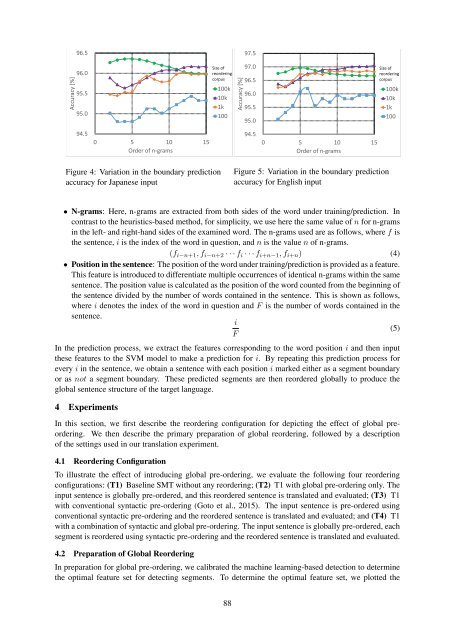December 11-16 2016 Osaka Japan
W16-46
W16-46
Create successful ePaper yourself
Turn your PDF publications into a flip-book with our unique Google optimized e-Paper software.
96.5<br />
97.5<br />
Accuracy [%]<br />
96.0<br />
95.5<br />
95.0<br />
Size of<br />
reordering<br />
corpus<br />
100k<br />
10k<br />
1k<br />
100<br />
Accuracy [%]<br />
97.0<br />
96.5<br />
96.0<br />
95.5<br />
95.0<br />
Size of<br />
reordering<br />
corpus<br />
100k<br />
10k<br />
1k<br />
100<br />
94.5<br />
0 5 10 15<br />
Order of n-grams<br />
94.5<br />
0 5 10 15<br />
Order of n-grams<br />
Figure 4: Variation in the boundary prediction<br />
accuracy for <strong>Japan</strong>ese input<br />
Figure 5: Variation in the boundary prediction<br />
accuracy for English input<br />
• N-grams: Here, n-grams are extracted from both sides of the word under training/prediction. In<br />
contrast to the heuristics-based method, for simplicity, we use here the same value of n for n-grams<br />
in the left- and right-hand sides of the examined word. The n-grams used are as follows, where f is<br />
the sentence, i is the index of the word in question, and n is the value n of n-grams.<br />
(f i−n+1 , f i−n+2 · · · f i · · · f i+n−1 , f i+n ) (4)<br />
• Position in the sentence: The position of the word under training/prediction is provided as a feature.<br />
This feature is introduced to differentiate multiple occurrences of identical n-grams within the same<br />
sentence. The position value is calculated as the position of the word counted from the beginning of<br />
the sentence divided by the number of words contained in the sentence. This is shown as follows,<br />
where i denotes the index of the word in question and F is the number of words contained in the<br />
sentence.<br />
i<br />
(5)<br />
F<br />
In the prediction process, we extract the features corresponding to the word position i and then input<br />
these features to the SVM model to make a prediction for i. By repeating this prediction process for<br />
every i in the sentence, we obtain a sentence with each position i marked either as a segment boundary<br />
or as not a segment boundary. These predicted segments are then reordered globally to produce the<br />
global sentence structure of the target language.<br />
4 Experiments<br />
In this section, we first describe the reordering configuration for depicting the effect of global preordering.<br />
We then describe the primary preparation of global reordering, followed by a description<br />
of the settings used in our translation experiment.<br />
4.1 Reordering Configuration<br />
To illustrate the effect of introducing global pre-ordering, we evaluate the following four reordering<br />
configurations: (T1) Baseline SMT without any reordering; (T2) T1 with global pre-ordering only. The<br />
input sentence is globally pre-ordered, and this reordered sentence is translated and evaluated; (T3) T1<br />
with conventional syntactic pre-ordering (Goto et al., 2015). The input sentence is pre-ordered using<br />
conventional syntactic pre-ordering and the reordered sentence is translated and evaluated; and (T4) T1<br />
with a combination of syntactic and global pre-ordering. The input sentence is globally pre-ordered, each<br />
segment is reordered using syntactic pre-ordering and the reordered sentence is translated and evaluated.<br />
4.2 Preparation of Global Reordering<br />
In preparation for global pre-ordering, we calibrated the machine learning-based detection to determine<br />
the optimal feature set for detecting segments. To determine the optimal feature set, we plotted the<br />
88



